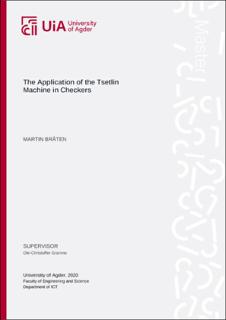| dc.contributor.author | Bråten, Martin | |
| dc.date.accessioned | 2020-10-15T10:17:12Z | |
| dc.date.available | 2020-10-15T10:17:12Z | |
| dc.date.issued | 2020 | |
| dc.identifier.citation | Bråten, M. (2020) The Application of the Tsetlin Machine in Checkers (Master's thesis). University of Agder, Grimstad | en_US |
| dc.identifier.uri | https://hdl.handle.net/11250/2683033 | |
| dc.description | Master's thesis in Information- and communication technology (IKT590) | en_US |
| dc.description.abstract | The Tsetlin Machine has shown promising results in the domain of board games such as Axis& Allies, showing that the Tsetlin Machine may be a contender to more well-known machine learning algorithms. This research aimed to find out how suitable the Tsetlin Machine is for the domain of Checkers, and how to best utilize it for the purpose of playing Checkers. In order to research this, the following questions had to be answered: Which Tsetlin Machine Configuration is best suited for predicting the results of Checkers games? To what degree can the Tsetlin Ma-chine predict the results of Checkers games? How well can a Checkers player using the Tsetlin Machine compete against Kingsrow? These questions were answered by creating a functional Checkers player with a Tsetlin Machinepredictor, for both to be tested. This was done by investigating how best to create datasets from a collection of data, which OCA 2.0 was chosen for, testing various configurations of the multiclass Tsetlin Machine with these datasets for finding well-fitted hyper-parameters and to find the most suited Tsetlin Machine configuration for predicting the results of Checkers boards. By self-play, further improvements were made. The proposed solution was a Checkers player using a tree search with the depth of three and a minimal amount of manually set rules, making it easier to evaluate the proposed Tsetlin Ma-chine predictor. The solution was shown to be the multiclass weighted Tsetlin Machine with positive boost using the hyper-parameters:clauses:19000,treshold:40000 ands:9; which was trained on the third K-Fold of the dataset NoDupeCheck StandardEnd, which was minimally altered from the data source. It utilized a separate Tsetlin Machine predictor for eaccolor, achieving accuracies of 72.21% and 72.12% respectively, and proved to be more accurate in this domain than numerous other machine learning algorithms. The Checkers player itself was not able to compete with Kingsrow, but beat a Checkers player making moves at random and was shown to have the skill comparable with that of a beginner-level human Checkers player. The code for the proposed solution can be accessed through the following URL:https://github.com/Fiskesuppen/TsetlinMachine-Checkers | en_US |
| dc.language.iso | eng | en_US |
| dc.publisher | University of Agder | en_US |
| dc.rights | Attribution-NonCommercial-NoDerivatives 4.0 Internasjonal | * |
| dc.rights.uri | http://creativecommons.org/licenses/by-nc-nd/4.0/deed.no | * |
| dc.subject | IKT590 | en_US |
| dc.title | The Application of the Tsetlin Machine in Checkers | en_US |
| dc.type | Master thesis | en_US |
| dc.rights.holder | © 2020 Martin Bråten | en_US |
| dc.subject.nsi | VDP::Teknologi: 500::Informasjons- og kommunikasjonsteknologi: 550 | en_US |
| dc.subject.nsi | VDP::Matematikk og Naturvitenskap: 400::Informasjons- og kommunikasjonsvitenskap: 420::Kunnskapsbaserte systemer: 425 | en_US |
| dc.source.pagenumber | 100 | en_US |

